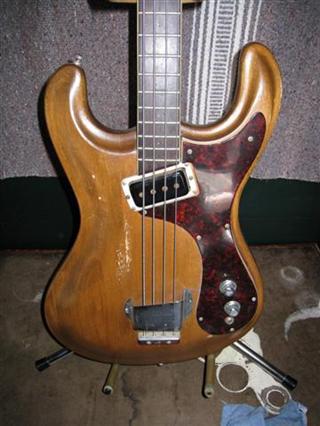Color question re: Whites and "Pearl White" etc.
Posted: Tue Apr 03, 2018 7:41 am
So to repeat from my intro post... Longtime owner of #5202 Type 3 bass, 64-54ish as best guess. Poor abused fellow who is finally getting a restoration/refin.
Pic of the 'starting point' below.
This instrument came to me for free something like 25-30yrs ago... and by then, sometime in 70's or 80's, it had been horribly stripped and refin'd in a 'natural' but EXTREMELY poorly. I mean sander gouge/tool marks, prolific runs all over it in the finish, but also just a way-too thin coat of whatever it was they used because it offered zero protection and the soft pine body would just take a dent if you looked at it... Really terrible. And I gigged with this poor guy a number of times so it got banged around a lot too... (in my yout' I also probably 'treated it like a free guitar' which didn't help...)
Luckily they left signs of the original color in the control cavity. Seems it was a creamy-white just on the yellow side of the spectrum.
Bringing me to my question... Internet shows me a lot of yellow-cream-white survivor examples, so I'm pretty confident if I more or less match that color I'll be in good shape.
But then there's these references to 'Pearl' white. Now some guitars listed as 'Pearl White' turn out too look exactly like the (flat, non-pearl) color I am looking at, and it's like somebody doesn't know what 'Pearl' paint means (or is being intentionally misleading because they think calling it "Pearl!" brings more premium...). But a few seem indeed do have a light actual real pearl in the paint.
Can somebody tell me, were there indeed 2 white colors around that timeframe? Any idea how the pearl was laid down? Was it a base-coat of white followed by a topcoat of pearl? If that was the case then this instrument I"m looking at could have been pearl I suppose, and maybe the pearl topcoats just didn't make it into the cavity. If it was a single pearled color laid down then I'm pretty sure that's not what it was, as the cavity is pretty flat. I'm pretty sure this flattish-cream color is just what I want to put on it, but thought it worthwhile asking first...
Thanks in advance. Here's the 'before' pic which is a pretty old one actually... At this point its all torn down and i've blasted and sanded the awful refin down and getting ready for a whole lot of light glazing work to repair dings and damage - some from general use, and some from the previous crap refin. Lord why somebody thought it was worth all that effort to remove the white color and make it this poo brown, I have NO idea...!

Pic of the 'starting point' below.
This instrument came to me for free something like 25-30yrs ago... and by then, sometime in 70's or 80's, it had been horribly stripped and refin'd in a 'natural' but EXTREMELY poorly. I mean sander gouge/tool marks, prolific runs all over it in the finish, but also just a way-too thin coat of whatever it was they used because it offered zero protection and the soft pine body would just take a dent if you looked at it... Really terrible. And I gigged with this poor guy a number of times so it got banged around a lot too... (in my yout' I also probably 'treated it like a free guitar' which didn't help...)
Luckily they left signs of the original color in the control cavity. Seems it was a creamy-white just on the yellow side of the spectrum.
Bringing me to my question... Internet shows me a lot of yellow-cream-white survivor examples, so I'm pretty confident if I more or less match that color I'll be in good shape.
But then there's these references to 'Pearl' white. Now some guitars listed as 'Pearl White' turn out too look exactly like the (flat, non-pearl) color I am looking at, and it's like somebody doesn't know what 'Pearl' paint means (or is being intentionally misleading because they think calling it "Pearl!" brings more premium...). But a few seem indeed do have a light actual real pearl in the paint.
Can somebody tell me, were there indeed 2 white colors around that timeframe? Any idea how the pearl was laid down? Was it a base-coat of white followed by a topcoat of pearl? If that was the case then this instrument I"m looking at could have been pearl I suppose, and maybe the pearl topcoats just didn't make it into the cavity. If it was a single pearled color laid down then I'm pretty sure that's not what it was, as the cavity is pretty flat. I'm pretty sure this flattish-cream color is just what I want to put on it, but thought it worthwhile asking first...
Thanks in advance. Here's the 'before' pic which is a pretty old one actually... At this point its all torn down and i've blasted and sanded the awful refin down and getting ready for a whole lot of light glazing work to repair dings and damage - some from general use, and some from the previous crap refin. Lord why somebody thought it was worth all that effort to remove the white color and make it this poo brown, I have NO idea...!
